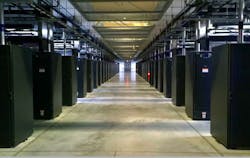Who are the Data Center’s Industry’s Hyperscale Players?
Data Center Frontier continues to explore the fastest growing markets and niches in the data center market via our DCF Special Reports. This time around, Data Center Frontier partners with Iron Mountain to explore the hyperscale data center market, and how its growth has changed how we compute. This excerpt from a recent Hyperscale Data Center explores the data center industry’s hyperscale players and the ins and outs of the the concept of ‘build vs buy.’
Download the full report.
The hyperscale market is composed of two tiers of companies, with slightly different characteristics. Both sets of customers have requirements that go beyond the traditional scope of the turn-key wholesale data center suite.
Tier 1
The Mega Hyperscale Operators
These companies are the dominant players in cloud services and social media. This includes Google, Microsoft, Amazon Web Services, Facebook and Apple. Chinese cloud giant Alibaba is also reaching the scale to be included in this group. Their deal sizes range from 10 megawatts (MWs) to 70 megawatts, and can include multiple data halls in a single building, multiple data halls across several buildings, a build-to-suit project, or even a multi-building campus.
Tier 2
SAAS, Platform Companies & Cloudlets
The second tier of hyperscale customers includes cloud providers like Oracle, Baiduand and China Telecom, along with SaaS providers like Salesforce, SAP, Workday, Paypal, Dropbox and platform companies like Uber and Lyft. These customers are seeking 2 to 5 megawatts at a time, and covet the ability to “land and expand” by growing into adjacent space.
Providers seeking hyperscale deals are now offering data halls ranging from 30,000 to 60,000 SF, with some building open rooms as large as 140,000 SF.
Prior to 2016, the wholesale data center market rarely saw deals larger than 10 MWs.The super-sizing of hyperscale requirements has altered the provisioning of wholesale data center space, which offers turn-key data halls with power, connectivity and cooling in place.
For many years, wholesale providers standardized on a form factor featuring data suites of approximately 1.2 MWs of IT capacity and 10,000 to 12,000 square feet (SF). Providers seeking hyperscale deals are now offering data halls ranging from 30,000 to 60,000 SF, with some building open rooms as large as 140,000 SF.
This trend is driving a segmentation of the data center industry, as some companies are optimizing their construction process and supply chain to compete for hyperscale deals, some are targeting more traditional enterprise wholesale requirements, and retail colocation players are focusing on interconnection and cloud on-ramps.
Build or Buy?
The Tier 1 hyperscale companies have the ability to either build their own data centers, lease space from wholesale data center providers, or partner with developers on build-to-suit projects. Their decisions are often guided by cost and how quickly they need the capacity. In some cases, data center REITs have won Tier 1 hyperscale deals on their ability to deploy data center space faster than in-house construction operations.
Approaches vary among Tier 1 providers. Amazon Web Services often leases powered shells – buildings with the power and fiber connectivity already in place, but no developed technical space—and then completes the buildout itself. Powered shell leases are also common in international markets.
Tier 2 hyperscale companies have shown a strong preference for leasing wholesale space and working closely with data center developers to create roadmaps for long-term growth.
In some geographic markets, hyperscale companies opt for wholesale space so they can start small as they initiate service, and then add capacity incrementally as needed. This is a common approach in international markets, as well as in edge deployment to enhance latency or connect segments of global networks.
The Outsized Influence of Hyperscale Customers
Synergy Research estimates that there are 439 hyperscale data centers worldwide. Meanwhile, 451 Research says it tracks 6,100 data centers globally. Although hyperscale data centers represent less than 10 percent of data centers by number, they represent an outsized share of new investment in infrastructure and servers.
Capital expenditures by the 20 largest global hyperscale providers surged 43 percent in 2018 to almost $120 billion, according to Synergy Research. In some markets, hyperscale leasing represents the lion’s share of activity. JLL estimates that hyperscale deals of 6 MWs or more represented 83 percent of leasing in Northern Virginia in 2018.
Meanwhile, server sales for companies that focus on custom hardware for hyperscale operators have been rising. IDC reports that about 30 percent of server sales in the first quarter of 2019 went to specialists in hyperscale gear, including ODM (original design manufacturing) vendors and Open Compute specialist Inspur.
“Hyperscalers will continue to heavily influence the IT infrastructure industry, both by the scale of their infrastructure investments and with the innovations those investments generate,” said Kuba Stolarski, research director, Computing Platforms, Worldwide Infrastructure, at IDC.
Over time, the global population of hyperscale facilities could grow to 10,000 or more data centers, according to an analysis by James Hamilton of AWS, who predicts that the need for latency and redundancy will create interconnected cloud clusters across the globe. The rapid adoption of AI will help drive this growth, which underscores the outsized impact of the hyperscale sector going forward.
Next week, the new article in the Hyperscale Data Center Market report will cover how a hyperscale data center is different, and the geography of hyperscale data centers. And in case you missed it, last week’s feature highlighted the impact of hyperscale data centers in today’s market.
Download the full report, “Hyperscale Data Centers,” courtesy of Iron Mountain Data Centers, to learn more about how hyperscale computing has changed the supply chain for digital infrastructure, and how this computing shift will evolve.
About the Author



